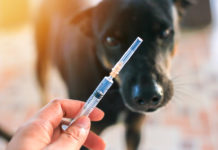So let’s talk about stray animals. What happens when a stray dog or cat comes across your path? Do you want to keep him, or do you think he’ll find his way home? Does he even have a home? Maybe you’re scared of him. Everybody has a different reaction, but one thing for sure; a stray animal probably needs your help. The best thing you can do is contact your county’s animal control and ask them to pick it up. The problem is that it may not hang out until help arrives.
If you are comfortable corralling the stray, then hold on to him until animal control arrives or bring him to the nearest government animal shelter. There, by law, they will scan for a microchip to locate his owner. If an owner cannot be found, they will hold the animal to see if an owner comes to claim him. After the hold period ends, the stray will most likely be spayed or neutered, put up for adoption, and hopefully find a forever home. If you are not comfortable capturing the animal, call animal control and give a detailed description of the animal and his location. Whatever you do, commit to making sure the animal makes it to the animal shelter.
If you want to adopt the animal, just make sure you communicate with the shelter, get your name on the adoption list or be there when he is ready for adoption. Just taking a stray without going through an animal shelter poses problems should a potential owner claim you stole him. The idea of “finders keepers” doesn’t really apply.
Our Georgia State Constitution, Article X, Paragraph III (a) (3), gives the power to pick up stray animals to counties and municipalities to protect the citizens from the dangers and nuisances that are associated with free roaming and diseased animals. Even a 1965 Georgia Attorney General opinion says the “local county board of health should adopt rules and regulation relative to catching and impounding of strays and unwanted dogs.” 19-65-66 (Op. Atty. Gen. No. 65-21).
Under the Compendium of Animal Rabies Prevention and Control, the constitution states, “stray dogs, cats and ferrets should be removed from the community. Local health departments and animal control officials can enforce the removal of strays more effectively if owned animals are confined or kept on a leash. Strays should be impounded for at least three days to determine if human exposure has occurred and to give owners sufficient time to reclaim animals. Allowing strays to go through an animal shelter allows for citizens to have an opportunity to reclaim their animal if it is impounded by providing a single entity that holds such animals and is legally designated.”
However, approximately thirty percent of Georgia counties do not have animal shelters. In that instance, you should contact your county commissioners, sheriff’s department, a licensed animal rescue organization (“rescue”) or a local veterinarian who may know what local resources are available.
Rescue organizations offer a great deal of support and resources, especially in counties that don’t have a government facility to impound strays. Rescues must be licensed through the Georgia Department of Agriculture (GA DOA) and are not allowed to pick up stray animals, but may only acquire animals that are relinquished by an owner or obtained from a licensed animal shelter. Under the Animal Protection Act rule 40-13-13-.04 (1) (h), each animal they obtain must have record of the name, address, and phone number of the individual involved in the transaction, date of transaction or activity, type and number of animals.
This was clarified in 2013 when rules were amended that defined an “Animal Shelter:” Section 40-13-13-.01 states that “only government agencies or organizations that are contracted with a government agency to perform animal control services have the authority to impound animals.”
The rules were also amended to include the definition of a rescue group 40-13-13-.01 (30) which states “rescue groups are not authorized to impound animals unless they are contracted by a government agency in Georgia to provide animal control services.” So unless a licensed rescue has a municipal contract, they may not pick up strays, but they can certainly work with an animal shelter to assist in holding them. If a rescue organization takes the stray after hold period, they need a transfer agreement from a municipal shelter and once they take custody, a 30-day spay-neuter law time clock starts ticking. Technically, anyone that is holding an animal with the permission of animal control should be signed up as an animal foster home.
Remember, you may be a stray animal’s only chance of survival. By taking immediate action, even if it’s just making a phone call, you can be a hero. For a more in-depth discussion about animals and the law, visit us at www.animallawsource.org, join for free and email us with your questions.





